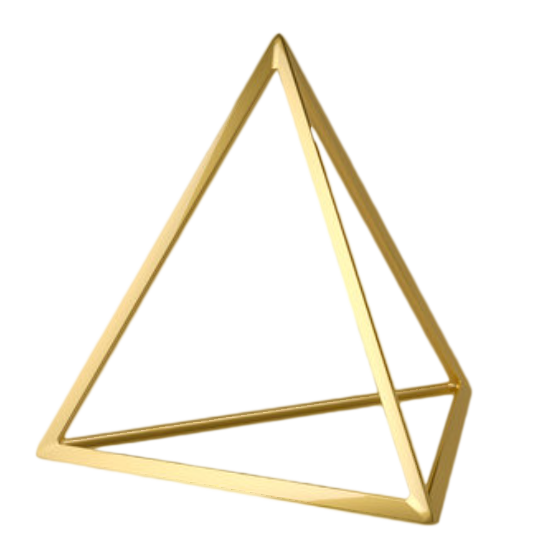A Template for System Thinking
Embark on a journey through the geometric bedrock of system thinking with the tetrahedron, guided by Buckminster Fuller’s groundbreaking ideas in “Synergetics,” which will lead to “The Reimagined I Ching” with flattened tetrahedron (see Flattening of tetrahedron). Discover the elegance and simplicity of the tetrahedron, a figure that not only underpins geometric knowledge but also acts as a quantum of structure, catalyzing a robust and streamlined methodology for problem-solving and the genesis of new concepts. This geometric form stands as a powerful template for innovation, shaping the landscape of system thinking and offering a blueprint for navigating complex challenges with clarity and ingenuity.
The Tetrahedron: A Quantum of Structure
Buckminster Fuller, a visionary in the realm of geometric thinking, introduced the tetrahedron as a fundamental building block in his seminal work, “Synergetics”. He posited that every polyhedron can be deconstructed into tetrahedral units, yet the tetrahedron itself stands indivisible, forming the bedrock of all geometric forms, including the five Platonic solids. This revelation positions the tetrahedron as the most basic and stable structure in geometry, likened to the “quantum of structure” for its unparalleled structural stability and simplicity.
- Foundational Geometry: The volume of a regular tetrahedron is considered ‘1’, making it the reference point against which the volumes of other Platonic solids (see the post, Geometry and Ancient Cosmology) are measured.
- Stability and Economy: With the least number of sides among polyhedrons, the tetrahedron exemplifies stability and economic construction, necessitating a minimum of six components for a stable three-dimensional form.
Tetrahedral Thinking: A Tool for Clarity and Synergy
Adopting a tetrahedral model in thought processes transcends conventional analytical methods by providing a stable, consistent, and economic framework. This “tool of thought” aids in distilling complex systems to their essence, eliminating redundancy and highlighting core components. It’s not just about solving problems, but about understanding the integral relationships and synergies within systems, aligning thought processes with the operational principles and content of the thinking system in question.
- Synergetic Analysis: Beyond linear or planar analysis, tetrahedral thinking embraces the three-dimensional interconnectedness of variables, offering insights into the synergistic effects that emerge from combining different system components.
Constructing the Tetrahedron: A Practical Guide
The construction of a tetrahedron, as Fuller illustrates, can be achieved by ingeniously assembling triangles, thereby transforming a two-dimensional plane into a three-dimensional structure. This process, whether by overlapping edges or pinning adjacent sides, reveals the tetrahedron’s inherent synergy, where ‘1 + 1 = 4’, epitomizing the concept that the whole is greater than the sum of its parts.
- Figure [a]: Natural tetrahedron
- Figure [b]: Demonstrates the creation of a tetrahedron using seven members, cleverly making it appear as seven members are used through overlapping.
- Figure [c]: Shows an alternative method, pinning two triangles to form a tetrahedral skeleton without an additional connecting member, emphasizing the concept of an ‘assembled’ tetrahedron with six members.

Figure [a] shows a regular tetrahedron
Figure [b] shows the two opposite sides of two triangles joined by a ring and a line connecting the two vertices of the distant symmetry, which looks like a regular tetrahedron but shows that the two triangles are the main members.
Figure [c] is the same construction as [b], but with two opposite sides clamped together and no connection to the two distant vertices of symmetry. This also shows that the two triangles are the main members of the tetrahedron.
The Tetrahedron in the Cosmos
Fuller’s exploration extends beyond geometry to encapsulate the essence of creativity and conceptualization. He suggests that the tetrahedron, as the most elementary form among the Platonic solids, serves as a template for systematic thinking, aligning perfectly with the four-dimensional fabric of space-time. This alignment fosters imagination and the actualization of concepts, ensuring that ideas are not only creative but systematically coherent and energy-efficient.
- Geometric Resonance: The principles of geometric composition, as manifested in the tetrahedron, resonate throughout the universe, echoing in the natural phenomena and the foundational structures of ideas and concepts.
- Creative Imagination and Conceptual Viability: By adhering to the tetrahedron’s principles, one can harness creative imagination more effectively, leading to concepts that are not only innovative but also viable and in harmony with the universe’s systematic and energy-efficient principles.
Conclusion: Embracing Geometric Wisdom for Future Innovations
The tetrahedron, as elucidated by Buckminster Fuller, offers more than just a geometric curiosity; it provides a profound template for systematic thinking and creativity. By understanding and applying the principles embodied by this simplest of Platonic solids, we can enhance our ability to think clearly, design efficiently, and innovate in ways that resonate with the fundamental patterns of the universe. If we flatten the tetrahedron, we meet the breakthrough application of I Ching tetrahedron to the methodology of “The Reimagined I Ching.”


Only wanna remark on few general things, The website layout is perfect, the content is very superb : D.
I will post really many topics on the “I Ching tetrahedron”, specially for the 64 personality against the MBTI.